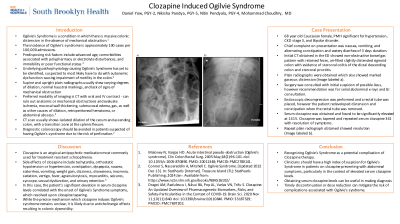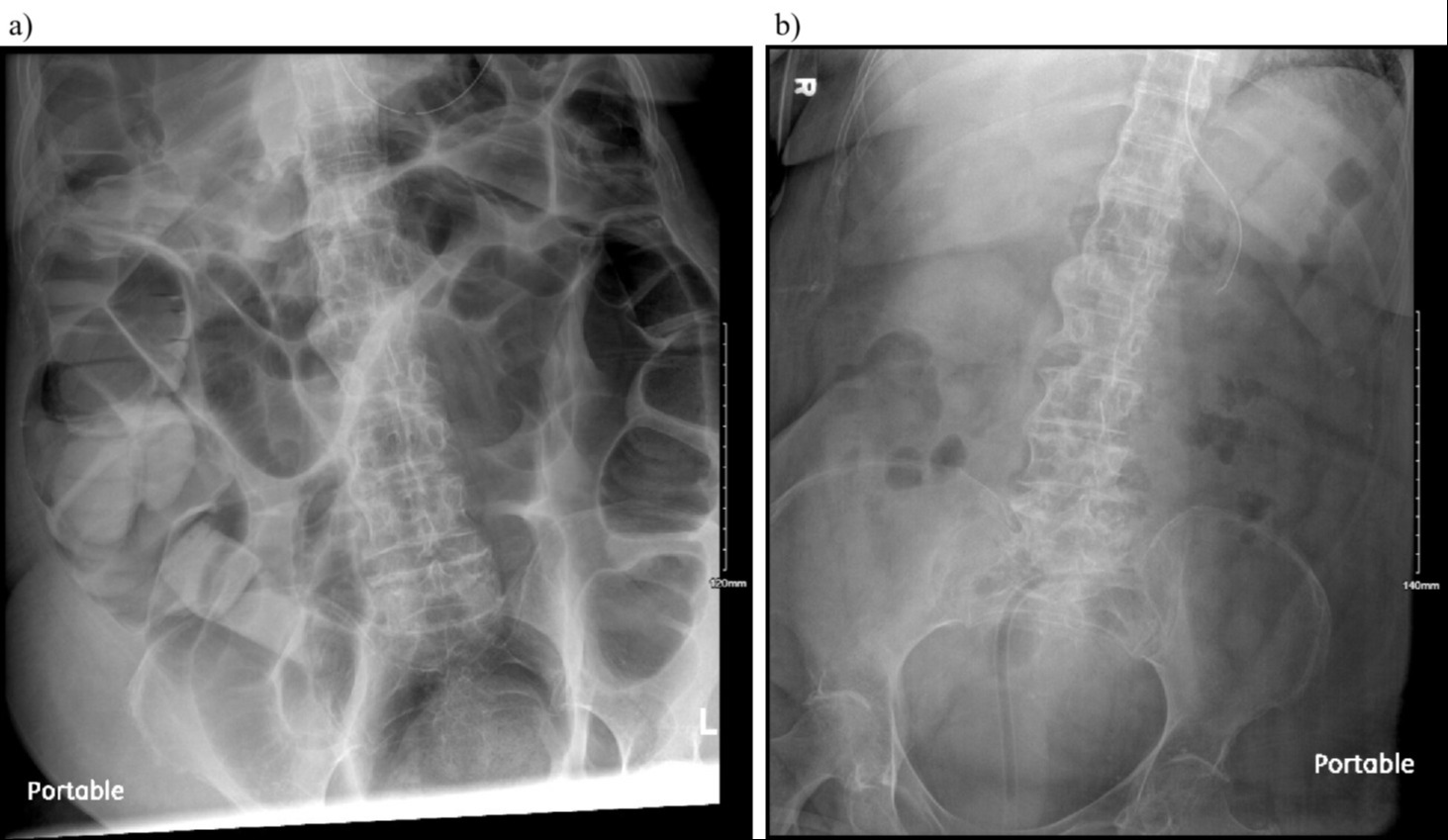Monday Poster Session
Category: Functional Bowel Disease
P2367 - Clozapine-Induced Ogilvie Syndrome
Monday, October 28, 2024
10:30 AM - 4:00 PM ET
Location: Exhibit Hall E

Has Audio
- NP
Nikisha Pandya, MD
South Brooklyn Health
Brooklyn, NY
Presenting Author(s)
Daniel Yow, MD, Nikisha Pandya, MD, Nitin Pendyala, MD, Mohammad Choudhry, MD
South Brooklyn Health, Brooklyn, NY
Introduction: Ogilvie's syndrome is a condition in which there is massive colonic distension in the absence of mechanical obstruction. The underlying pathophysiology causing Ogilvie's Syndrome is suspected to most likely be due to autonomic dysfunction causing impaired motility in the colon. Ogilvie's is usually a diagnosis of exclusion, however appropriate imaging is usually required for diagnosis. Radiographs are often obtained, and usually show varying degrees of dilation, normal haustral markings, and lack of signs of mechanical obstruction. Computed tomography (CT) with oral and intravenous contrast are the preferred imaging for diagnosis of Ogilvie's Syndrome. CT scan can rule out anatomic or mechanical obstructions and evaluate ischemia, mucosal wall thickening, submucosal edema, gas, as well as other causes of dilation, retroperitoneal hematoma, or abdominal abscess. CT scan of Ogilvie's Syndrome usually shows isolated dilation of the cecum and ascending colon, with a transition zone at the splenic flexure. Diagnostic colonoscopy should be avoided due to the risk of perforation.
Case Description/Methods: We present a case study of a 68-year-old woman with past medical history significant for hypertension, stage 3 chronic kidney disease and bipolar disorder who developed symptoms consistent with Ogilvie’s syndrome after prolonged use of clozapine. Initial imaging including abdominal CT scan and plain radiographs revealed signs of colonic distension without mechanical obstruction. GI evaluated the patient and endoscopic decompression was performed and a rectal tube was placed, however the patient redeveloped distension and constipation when the rectal tube was removed. Eventually serum clozapine levels were obtained which was significantly elevated at 1415. Clozapine was tapered with resolution of symptoms and repeat serum clozapine noted to be 341. Repeat plain radiograph was normal.
Discussion: Clozapine is an antipsychotic is known for its many side effects including constipation, which is a known predisposing factor for Ogilvie’s syndrome. This case highlights the importance of recognizing drug-induced Ogilvie’s syndrome especially in patients with predisposing risk factors. Patient's on clozapine are usually monitored for other side effects such as neutropenia, however other side effects such as constipation should be monitored and serum clozapine levels can be useful such as in this case. Timely recognition and management of gastrointestinal side effects contribute to favorable patient outcomes.

Disclosures:
Daniel Yow, MD, Nikisha Pandya, MD, Nitin Pendyala, MD, Mohammad Choudhry, MD. P2367 - Clozapine-Induced Ogilvie Syndrome, ACG 2024 Annual Scientific Meeting Abstracts. Philadelphia, PA: American College of Gastroenterology.
South Brooklyn Health, Brooklyn, NY
Introduction: Ogilvie's syndrome is a condition in which there is massive colonic distension in the absence of mechanical obstruction. The underlying pathophysiology causing Ogilvie's Syndrome is suspected to most likely be due to autonomic dysfunction causing impaired motility in the colon. Ogilvie's is usually a diagnosis of exclusion, however appropriate imaging is usually required for diagnosis. Radiographs are often obtained, and usually show varying degrees of dilation, normal haustral markings, and lack of signs of mechanical obstruction. Computed tomography (CT) with oral and intravenous contrast are the preferred imaging for diagnosis of Ogilvie's Syndrome. CT scan can rule out anatomic or mechanical obstructions and evaluate ischemia, mucosal wall thickening, submucosal edema, gas, as well as other causes of dilation, retroperitoneal hematoma, or abdominal abscess. CT scan of Ogilvie's Syndrome usually shows isolated dilation of the cecum and ascending colon, with a transition zone at the splenic flexure. Diagnostic colonoscopy should be avoided due to the risk of perforation.
Case Description/Methods: We present a case study of a 68-year-old woman with past medical history significant for hypertension, stage 3 chronic kidney disease and bipolar disorder who developed symptoms consistent with Ogilvie’s syndrome after prolonged use of clozapine. Initial imaging including abdominal CT scan and plain radiographs revealed signs of colonic distension without mechanical obstruction. GI evaluated the patient and endoscopic decompression was performed and a rectal tube was placed, however the patient redeveloped distension and constipation when the rectal tube was removed. Eventually serum clozapine levels were obtained which was significantly elevated at 1415. Clozapine was tapered with resolution of symptoms and repeat serum clozapine noted to be 341. Repeat plain radiograph was normal.
Discussion: Clozapine is an antipsychotic is known for its many side effects including constipation, which is a known predisposing factor for Ogilvie’s syndrome. This case highlights the importance of recognizing drug-induced Ogilvie’s syndrome especially in patients with predisposing risk factors. Patient's on clozapine are usually monitored for other side effects such as neutropenia, however other side effects such as constipation should be monitored and serum clozapine levels can be useful such as in this case. Timely recognition and management of gastrointestinal side effects contribute to favorable patient outcomes.

Figure: a) Plain radiograph featuring Ogilvie Syndrome - massive colonic dilatation without mechanical obstruction.
b) Normal plain radiograph in the same patient after tapering Clozapine with resolution of symptoms.
b) Normal plain radiograph in the same patient after tapering Clozapine with resolution of symptoms.
Disclosures:
Daniel Yow indicated no relevant financial relationships.
Nikisha Pandya indicated no relevant financial relationships.
Nitin Pendyala indicated no relevant financial relationships.
Mohammad Choudhry indicated no relevant financial relationships.
Daniel Yow, MD, Nikisha Pandya, MD, Nitin Pendyala, MD, Mohammad Choudhry, MD. P2367 - Clozapine-Induced Ogilvie Syndrome, ACG 2024 Annual Scientific Meeting Abstracts. Philadelphia, PA: American College of Gastroenterology.
